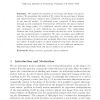Free Online Productivity Tools
i2Speak
i2Symbol
i2OCR
iTex2Img
iWeb2Print
iWeb2Shot
i2Type
iPdf2Split
iPdf2Merge
i2Bopomofo
i2Arabic
i2Style
i2Image
i2PDF
iLatex2Rtf
Sci2ools
137
Voted
ECCV
2002
Springer
2002
Springer
Local Analysis for 3D Reconstruction of Specular Surfaces - Part II
We analyze the problem of recovering the shape of a mirror surface. We generalize the results of [1], where the special case of planar and spherical mirror surfaces was considered, extending that analysis to any smooth surface. A calibrated scene composed of lines passing through a point is assumed. The lines are reflected by the mirror surface onto the image plane of a calibrated camera, where the intersection and orientation of such reflections are measured. The relationship between the local geometry of the surface around the point of reflection and the measurements is analyzed. We give necessary and sufficient conditions, as well as a practical algorithm, for recovering first order local information (positions and normals) when three intersecting lines are visible. A small number of `ghost solutions' may arise. Second order surface geometry may also be obtained up to one unknown parameter. Experimental results with real mirror surfaces are presented.
Computer Vision | ECCV 2002 | Mirror Surface | Order Surface Geometry | Real Mirror Surfaces | Smooth Surface | Spherical Mirror Surfaces |
Related Content
| Added | 16 Oct 2009 |
| Updated | 16 Oct 2009 |
| Type | Conference |
| Year | 2002 |
| Where | ECCV |
| Authors | Silvio Savarese, Pietro Perona |
Comments (0)

